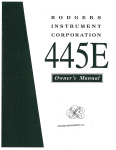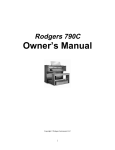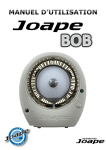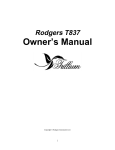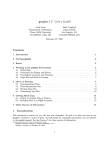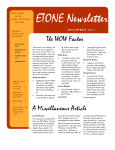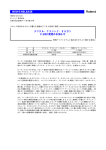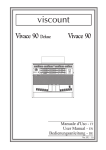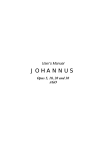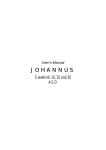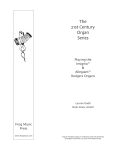Download Rodgers C-505 Owner`s manual
Transcript
C-440 C-445 C-505 · .Owner's Manual ROIGERS INSTRUMENT CORPORATION 1300 N.E. 25'" AVENUE • HILLSBORO, OREGON 97124 • 503/648•4181 WARNING: A ATTENTION: RISQUE DE CHOC ELECTRIOUE NE PAS OUVRIR CAUTION: TO REDUCE THE RISK OF ELECTRICAL SHOCK, DO NOT REMOVE COVER (OR BACK). NO USER-SERVICEABLE PARTS INSIDE REFER SERVICING TO QUALIFIED SERVICE PERSONNEL. TO REDUCE THE RISK OF FIRE OR ELECTRIC SHOCK. DO NOT EXPOSE THIS APPLIANCE TO RAIN OR MOISTURE. 1 PATENTS G.B. 1312161 F.R.G. 22 02 658 CANADIAN 951550 (1974) The lightning flash with arrowhead symbol, within an equilateral triangle, Is Intended to alert the user to the presence of uninsulated •dangerous voltage" within the product's enclosure that may be of sufficient magnitude to constitute a risk of electrical shock to persons. The exclamation point within an equilateral tr~angle is intended to alert the user to the presence of important . operating and maintenance (servicing) instructions in the literature accompanyingthe product. NOTICE TO USERS Information in this document is subject to change without notice. No part of this manual may be translated into any language, stored in a retrieval system, reproduced or transmitted in any form or by any means, electronic _ or mechanical, including photocopying and recording, for any purpose without the express written permission of Rodgers Instrument Corporation. RODGERS INSTRUMENT CORPORATION 1300 NE 25th Avenue Hillsboro OR 97124 (503) 648-4181 ° Copyright 1991, Rodgers Instrument Corporation. Printed in the United States of America. All rights reserved. ADDENDUM TO OWNER·'S MANUAL Please follow the instructions below to properly operate the Bass Coupler and the Melody Coupler. This is to replace pages 6 and 7 in the C-440/C-445/C-505 owner's manual. 5/17/91 THE BASS COUPLER This feature's name is derived from the ancient term "Basso Contiimo," meaning .thoroughbass. When this tilt tab is pressed, it will light Any stops or couplers on in the Pedal division will sound from the lowest key being played on the Great manual. This provides a pedal bass without having to actually play the pedalboard with the feet. In its normal setting, the Bass Coupler affects keys 1 through 24 of the Great manual, but its range is programmable. n- HOW TO SET THE RANGE OF THE BASS COUPLER: 1. Hold SET and press the BASS tilt tab, which will start flashing. 2. Release the SET piston. 3. While the BASS tilt tab is flashing, press a key which corresponds to the highest note the range is to extend. Any note from key 1 to key 61 may be selected. Keys above 32 will play external MIDI devices but will not play the Pedal stops. After the selected key has been pressed, the BASS tilt tab will shut off. (Note: When key is pressed to set the range, no sound will be heard even if stops are on, so no disturbance will be made if programming during a performance.) ' 4. To use the new range, press the BASS tilt tab. 6 THE MELODY COUPLER When the MELODY tilt tab is pressed, it will light. Any stop or coupler of the Swell division will sound from the highest key being played on the Great manual. This allows a solo melody and anaccompaniment to be played from the same manual. In its normal setting, the Melody Coupler affects keys 25 through 61 on the Great manual, but its range is programmable. n- HOW TO SET THE RANGE OF THE MELODY COUPLER: I. Hold SET and press the MELODY tilt tab, which starts flashing. 2. Release the SET piston. 3. While the MELODY tilt tab is flashing, press a key which corresponds to the lowest note the range is to extend. Any note from key I to key 61 may be selected. After the selected key has been pressed, the MELODY tilt tab will stop flashing. ·7 Safety Instructions INSTRUCTIONS PERTAINING TO A RISK OF FIRE, ELECTRIC SHOCK OR INJURY TO PERSONS IMPORTANT SAFETY INSTRUCTIONSWARNING When using this instrument, always follow basic precautions, including the following: 1) Read all the instructions before using, adjusting, or repairing this instrument. 10) Unplug the power cord of the instrument from the power source when left unused for a long periOd of time. 2) To reduce the risk of injury, supervise children closely when children are around the instrument. 11) Do not walk on, or place objects on top of the power cord. 3) Use this instrument only in the manner recommended by Rodgers Instrument Corp. 12) Do not pull the cord, rather hold the plug when unplugging the power cord plug Trom the power source. 4) Do not use this instrument near water, for example, near a swimming pool, a damp or wet room. 13) When setting up with other instruments or peripherals, follow the procedures in accordance with Rodgers' instruction manual. 14) Take care so that objects do not fall or liquids spill into the instrument. 15) Service the instrument with qualified Sc:rvice personnel when: 5) Use of this instrument, either alone or in combination with an amplifier and headphones or speakers, may be capable of producing souna levels that could cause permanent hearing loss. DO NOT operate for a long period of time at a high volume level or at a level that is uncomfortable. If you experience any hearing loss or ringing in the ears, you should consult an audiologist. a. The power cord or plug has been damaged. 6) Locate the instrument so its position does not interfere with its proper ventilation. b. Objects have fallen or liquid has spilled into the instrument. 7) Locate the instrument away from heat sources such as radiators, heat registers, or other products- that radiate heat airectly onto the Instrument. c. The instrument has been exposed to rain or other weather damage. 8) Protect the instrument from dust as much as possible. 9) Connect the instrument to a power source only of the type described in the operating instructions or as marked on the instrument. Do NOT attempt to defeat the grounding connection of the three-prong attachment plug. This is a safety feature. If you are unable to insert the plug into the outlet, contact an electrician to replace your obsolete outlet. Do NOT defeat the safety purpose of the plug. d. The instrument does not appear to operate normally, or exhibits a marked cltange in performance. e. The instrument has been dropped or the enclosure damaged. 16) Do not attempt to service the instrument beyond that described in the user maintenance or technical service manuals. Refer all other servicing to qualified technical service personnel. WARNING: THIS INSTRUMENT MUST BE EARTH GROUNDED. You must GROUND instruments equipped with a TYPE AC, 3 WIRE GROUND PLUG. SAVE THESE INSTRUCTIONS i FCC Notice Radio and Television Interference The Rodgers Classic Keyboards111 uses and generates small amounts of radio-frequency (RF) energy. The instrument complies with the limits set for Class B digital devices. FCC Rules, Part 15, Subpart B define the limits for radio and television interference in a residential installation. Follow the installation and the use instructions in this manual, or the instrument could potentially cause interference with some radio or television reception. In the unlikely event that this occurs, we encourage the user to try the following corrective measures. • Turn the instrument OFF to see if it is the actual source of the interference. • Disconnect the peripheral devices and their input/output cables one at a time. If the interference stops, it is caused by the peripheral device or its 1/0 cable. • Try coiling and uncoiling the instrument's power cord in different ways. • Connect the instrument's power cord to a power outlet on a different circuit. • Move th~ instrument farther away from the radio or television receiver. • Turn the radio or television receiver until the interference stops. • Connect the radio or television receiver to a different power circuit. • Reorient or move the receiver antenna farther away from the instrument. Consider installing a rooftop antenna with coaxial cable lead-in between the antenna and receiver. • Consult the nearest Rodgers Classic Keyboards111 dealer for more information if the above corrective measures don't remove the interference. ii Table of Contents CAUTIONS and Notice to Users Safety Instructions FCC Notice Table of Contents inside cover i ii iii Overview of the C-440, C-445 and C-505 page 1 Brief Tour Tum On!fum Off Divisions Selecting Or Retiring A Stop Combination Action Couplers Tremulants Expression Pedal (C-440) Expression Pedals (C-445 & C-505) Great/Pedal Unenclosed (C-440) Great to Swell Expression Coupler (C-445 & C-505) The Bass Coupler The Melody Coupler Tuning Knob Transposer Knob Headphone Jack MIDI page page page page page page page page page page page page page page page page page Specification C-440 page 9 Specification C-445 and C-505 page 10 Suggested Registrations page 11 Care and Maintenance page 24 2 2 2 2 3 4 4 5 5 5 5 6 7 8 8 8 8 1ll OVERVIEW OF THE C-440, C-445 & C-505 Congratulations on your purchase of a Rodgers Classic Keyboards® C-440,C-445 or C-505. The "C" series organs are high quality church organs in both sound ~nd construction, designed to provide years of reliable service. The "C" series instruments are two-manual classical organs that incorporate an eclectic specification and authentic pipe organ sounds. In addition to a built-in two-channel stereo audio system, the C-440, C-445 and C-505 have provisions for additional amplification and speakers. The "C" series organs utilize lighted tilt tab stop controls. Traditional couplers are included, as well as an adjustable combination action (pistons) with one memory on the C-440 and two memories on the C-445 and C-505. The Rodgers "C" series organs are completely voiced and tuned for optimum tonal authenticity. A Rodgers factory-trained technician can provide additional voicing and finishing as required. These instruments offer full MIDI (Musical Instrument Digital Interface) capability, allowing the organist to control other MIDI devices (keyboards, sequencers, rhythm units, sound modules, etc.). MIDI allows the performer full recording and playback capabilities. Thank you for choosing a Rodgers Classic Keyboards® C-440, C-445 or C-505. Through the most advanced technology available, Rodgers Instrument Corporation delivers proven reliability and tradition of musical excellence and innovation marking our position as The Sound Choice! 1 To get started, here is a brief tour of the basic operations of Rodgers C-440, C-445 & C-505: TURN ON/TURN OFF To tum the organ on, press the power rocker switch at the top (1). In approximately 5 seconds, the the SET piston will light, indicating the power is on and the organ is ready to play. To tum the power off, press the power rocker switch at the bottom (0). The power to the organ is off. DIVISIONS The following groupings of stops (tilt tabs) affect the indicated manuals (keyboards) or pedalboard: COUPLERS 0 SWELL PEDAL 'l .-----1- l\ J "'"'NERALS I ;:::.. ~toJ H=I-H~l=HII]I liaFH+ ;(?I;J / I':!DI::AT u_ l ~ ........ I/ EXPRESSION!445/505l !Or General Expression-4401 GT_ & PEDAL EXPRESS, (445/505) =:i Ill ~-·~ \\~ ' 11\1 ,\ ==== ===== '='== ..... ---= ---::::;_;; r-- y PEDAL#\\ tl \I I 1::::::- \ ----= SELECTING OR RETIRING A STOP Press the bottom of the desired tilt tab to tum it on. It will light, indicating it is on. Press the top of the tilt tab to tum off the stop. The light will go off, indicating the stop is off. 2 COMBINATION ACTION (Pistons) The C-440, C-445 and C-505 feature a combination action easily changed by the organist from the console. The organist can pre-select favorite registrations and make rapid changes in tone color using this advanced system. The pistons will light when pressed. The C-440 combination action includes five general pistons, a SET piston and a GENERAL CANCEL piston. The C-445 and C-505 combination action includes ten general pistons, a SET piston and a GENERAL CANCEL piston. The C-445 and C-505 also include a dual memory combination action (M2) and ten toe studs which duplicate the ten general pistons. GENERAL PISTONS 1-5 (All Instruments) GENERAL PISTONS<Toe Studs) ~ 1-5 (445/505) leall 1 ~HOW GENERAL PISTONS 6-10 (445/505) Ill GENERAL PISTONS <Toe Studs) \ 111 6-10 (4~-~/505 [118\1~ TO SET THE PISTONS: 1. Select the stops desired. 2. Push the SET piston and hold. 3. While holding the SET piston, push the desired piston and then release both pistons simultaneously. (Note: On the C-445 and C-505, selecting M2 before steps 1-3 will activate a second memory, thereby doubling the number of combinations available.) 3 COUPLERS ~ Couplers enable stops of one division to be played on another keyboard or pedalboard. The couplers on the "C" series organs are GREAT TO PEDAL, SWELL TO PEDAL and SWELL TO GREAT. Notes heard with Swell To Great coupler added Keys played and heard, TREMULANTS Tremulants create changes in pitch (sharp and flat) or amplitude (volume). The use of tremulants adds warmth to solo or small ensemble combinations and is useful in gospel and romantic music. The "C" series organs have a MAIN TREMULANT that affects all manual voices. The SWELL FLUTE TREMULANT FULL affects all the flute voices on the Swell manual. It is a deeper and faster tremulant than the other tremulant. Each independent tremulant is adjustable for both speed and depth. It is recommended that these adjustments be made by Authorized Personnel Only. 4 EXPRESSION PEDAL (C-440) This pedal controls the overall volume of the entire organ. This pedal is used to give variety of expression to the music played. Pressing the pedal forward increases the volume; drawing back decreases the volume. EXPRESSION PEDALS (C-445 and C-505) The pedal on the right controls the overall volume of the Swell division. The pedal on the left controls the overall volume of the Great and Pedal divisions. These pedals are used to give variety of expression to the music played. Pressing the pedal forward increases the volume; drawing back decreases the volume. GREAT/PEDAL UNENCLOSED (C-440) Many traditional pipe organs are tonally designed with the Great and Pedal divisions non-expressive. On the C-440, the Great and Pedal divisions are normally expressed with the expression pedal. If a more traditional effect is desired by the organist, the Great/Pedal Unenclosed tilt tab allows the Great and Pedal divisions to play at full volume, while the Swell remains under expression. GREAT TO SWELL EXPRESSION COUPLER (C-445 and C-505) The Great to Swell Expression Coupler allows the Great and Swell divisions to be expressed by using the right expression pedal. 5 THE BASS COUPLER This feature's name is derived from the ancient term "Basso Continuo," meaning thorough bass. When this tilt tab is pressed, it will light. Any stops or couplers on in the Pedal division will sound from the lowest key being played on the Great manual. This provides a pedal bass without having to actually play the pedalboard with the feet. In its normal setting, the Bass Coupler affects keys 1through 24 of the Great manual, but its range is programmable. As few notes as 1 through 13, or as many notes as 1 through 32 may be programmed. n- HOW TO SET THE RANGE OF THE BASS COUPLER: 1. Hold SET and press the BASS tilt tab, which will start flashing. 2. Release the SET piston. 3. While the BASS tilt tab is flashing, press a key which corresponds to the highest note the range is to extend. Any note from key 13 to key 32 may be selected. After the selected key has been pressed, the BASS tilt tab will shut off. (Note: When key is pressed to set the range, no sound will be heard even if stops are on, so no disturbance will be made if programming during a performance.) 4. To use the new range, press the BASS tilt tab. (Note: When the organ is turned off, the range of the Bass Coupler will revert to notes 1 through 24.) c: 6 :~ THE MELODY COUPLER When the MELODY tilt tab is pressed, it will light. Any stop or coupler of the Swell division will sound from the highest key being played on the Great manual. This allows a solo melody and an accompaniment to be played from the same manual. In its normal setting, the Melody Coupler affects keys 25 through 61 on the Great manual, but its range is programmable. The range may be extended down to key 13, or it may stop at key 49. ~HOW TO SET THE RANGE OF THE MELODY COUPLER: 1. Hold SET and press the MELODY tilt tab, which starts flashing. 2. Release the SET piston. 3. While the MELODY tilt tab is flashing, press a key which corresponds to the lowest note the range is to extend. Any note from key 13 to key 49 may be selected. After the selected key has been pressed, the MELODY tilt tab will stop flashing. (Note: When the organ is turned off, the range of the Melody Coupler will revert to keys 25 through 61.) c: :~ 7 TUNING KNOB The "C" series organs are equipped with a TUNING knob. This allows the entire organ to be tuned easily and quickly to a piano or musical instrument not at standard concert pitch (A 440). If the TUNING knob is pushed in, the organ will remain at standard concert pitch, and turning the knob will have no effect. To alter the pitch, pull the TUNING knob out until it clicks, then tum the knob to set the pitch. TRANSPOSER KNOB Turning the TRANS POSER knob will raise or lower the pitch of the organ up to four semitones (half steps). Many singers need a key change to accommodate their voice range. The TRANSPOSER is especially useful for accompanying soloists, eliminating the need to mentally transpose music on a printed sheet into a more suitable key. The TRANSPOSER helps the organist accomplish this effortlessly. v HEADPHONE JACK The "C" series organs have a Headphone Jack located under the keydesk to the right. When a set of headphones is plugged into the jack, the speaker system shuts off, allowing the organist privacy when playing. It is recommended that you use a standard 8 ohm stereo headphone set. Your Headphone Jack is designed to run only ONE set of headphones at a time. MIDI (Musical Instrument Digital Interface) The "C" series organs possess the most advanced MIDI capability in the industry. MIDI voices are activated on the "C" series organs via three MIDI tilt tabs. For information on Rodgers complete MIDI capabilities, please refer to the detailed MIDI Phase III instruction manual available from your Rodgers Representative. 8 I C-440 SPECIFICATIONS GREAT ORGAN PEDAL ORGAN Principal 8' Rohrflote 8' Flauto Dolce 8' Flute Celeste 8' Octave 4' Spitzflote 4' Super Octave' Quintflote 1 1/3' Mixture IV rks Cromome8' Chimes Swell to Great Principal16' Subbass 16' Octave 8' Gedackt 8' Choral Bass 4' Fagott 16' Great to Pedal Swell to Pedal SWELL ORGAN Lieblich Bourdon 16' Bourdon 8' Viola 8' Viola Celeste 8' Prestant 4' Koppelflote 4' Nazard 2 2/3' Blockflote 2' Plein J eu IV rks Contre Basson 16' Trompette 8' Hautbois 8' I GENERAL Tremulant (Great and Swell) Swell Flute Tremulant Full Bass Coupler Melody Coupler Great/Pedal Unenclosed MIDI on Pedal MIDI on Swell MIDI on Great ACCESSORIES Transposer Knob Tuning Knob Headphone Jack External Audio Jacks Expression Pedal 5 General Pistons (single memory) Set General Cancel 9 I C-445 & C-505 SPECIFICATIONS GREAT ORGAN PEDAL ORGAN Principal 8' Rohrflote 8' Flauto Dolce 8' Flute Celeste 8' Octave 4' Spitzflote 4' Super Octave 2' Quintflote 1 1/3' Mixture N rks Cromorne 8' Chimes Swell to Great Principal 16' Subbass 16' Octave 8' Gedackt 8 Choral Bass 4' Fagott 16' Great to Pedal Swell to Pedal SWELL ORGAN Lieblich Bourdon 16' Bourdon 8' Viola 8' Viola Celeste 8' Prestant 4' Koppelflote 4' Nazard 2 2/3' Blockflote 2' Plein Jeu IV rks Contre Basson 16' Trompette 8' Hautbois 8' 10 GENERAL Tremulant (Great and Swell) Swell Flute Tremulant Full Bass Coupler Melody Coupler Great to Swell Expression MIDI on Pedal MIDI on Swell MIDI on Great ACCESSORIES Transposer Knob Tuning Knob Headphone Jack External Audio Jacks Expression Pedal (Great/Pedal) Expression Pedal (Swell) 10 General Pistons (dual memory) Memory 2 Piston (lighted) 10 General Toe Studs (duplicate of thumb pistons) Set General Cancel SUGGESTED REGISTRATIONS The following pages of registrations are guidelines for selecting appropriate stops to match broad suggestions given in most printed organ literature. There will be variances of registration, depending upon the music, acoustics of the room, and the spirit of the performance. GREAT ORGAN Given Suggestions Appropriate registrations FLUTE Rohrflote S' SOFfFLUTE Flute Celeste S' FOUNDATIONS p Rohrflote S' Flute Dolce S' Spitzflote 4' FOUNDATIONS mf Principal S' Spitzflote 4' FOUNDATIONS f PrincipalS' Rohrflote S' Octave 4' Spitzflote 4' FOUNDATIONS If PrincipalS' Rohrflote S' Octave 4' Spitzflote 4' Super Octave 2' Fourniture IV FULL GREAT PrincipalS' Rohrflote S' Octave 4' Spitzflote 4' Super Octave 2' Quintflote 1 1/3' Fourniture N Cromorne S' 11 SWELL ORGAN Given Suggestions Appropriate Registrations STOPPED FLUTE Bourdon 8' STRINGS Viola 8' Viola Celeste 8' STRING ENSEMBLE Viola 8' Viola Celeste 8' Bourdon 8' Koppelflote 4' Tremulant SOLO REED I mf Hautbois 8' SOLO REED II mf Contre Basson 16' (play 8va) SOLO REED/ Trompette 8' CORNET Bourdon 8' Koppelflote 4' Nazard 2 2/3' FOUNDATIONS mf Viola 8' Bourdon 8' Koppelflote 4' FOUNDATIONS f Viola 8' Bourdon 8' Prestant 4' Koppelflote 4' Blockflote 2' FOUNDATIONS ff Viola 8' Bourdon 8' Prestant 4' Koppelflote 4' Blockflote 2' Plein Jeu IV 12 FULL SWELL Viola 8' Bourdon 8' Prestant 4' Koppelflote 4' Blockflote 2' Plein Jeu IV Contre Basson 16' Trompette 8' Hautbois 8' PEDAL ORGAN Given Suggestions Appropriate Registrations SOFT BASS Subbass 16' FLUTES Subbass 16' Gedackt 8' FOUNDATIONS mf Lieblich Bourdon 16' Gedackt 8' FOUNDATIONS f Subbass 16' Principal 16' Gedackt 8' Octave 8' Choralbass 4' FOUNDATIONS ff Subbass 16' Principal 16' Gedackt 8' Octave 8' Choralbass 4' FULL PEDAL Subbass 16' Principal 16' Gedackt 8' Octave 8' Choralbass 4' Fagott 16' 13 ENSEMBLE COMBINATIONS SOFr PRAYER HYMN STRING CHORUS FULL STRING CHORUS 14 Great: Flute Celeste 8' Tremulant (optional) Swell: Viola 8' Viola Celeste 8' Pedal: Subbass 16' Couplers: Swell to Pedal Swell to Great Great: Principal 8' Flute Celeste 8' Tremulant (optional) Swell: Viola 8' Viola Celeste 8' Koppelflote 4' Pedal: Subbass 16' Couplers: Swell to Pedal Swell to Great Great: Rohrflote 8' Flute Celeste 8' Spitzflote 4' Tremulant (optional) Swell: Viola 8' Viola Celeste 8' Bourdon 8' Prestant 4' Koppelflote 4' Tremulant Pedal: Subbass 16' Couplers: Swell to Pedal Swell to Great SOFT FOUNDATIONS FOUNDATIONS 8' mf FOUNDATIONS 8' and 4' Great: Rohrflote 8' Swell: Viola 8' Bourdon 8' Pedal: Subbass 16' Couplers: Swell to Pedal Swell to Great Great: Principal 8' Spitzflote 4' Swell: Viola 8' Bourdon 8' Koppelflote 4' Pedal: Subbass 16' Couplers: Swell to Pedal Swell to Great Great: Principal 8' Octave 4' Spitzflote 4' Swell: Viola 8' Bourdon 8' Prestant 4' Koppelflote 4' Pedal: Subbass 16' Gedackt 8' Couplers: Swell to Pedal Swell to Great 15 FOUNDATIONS S' mf FOUNDATIONS S' and4' 16 Great: PrincipalS' Gernshorn S' Spitzflote 4' Swell: Geigen PrincipalS' Bourdon S' Koppelflote 4' Pedal: Subbass 16' Couplers: Swell to PedalS' Swell to Great S' Positiv to GreatS' Great: Principal S' Gernshorn S' Octave 4' Spitzflote 4' Swell: Geigen PrincipalS' Bourdon S' Prestant 4' Koppelflote 4' Pedal: Subbass 16' Gedackt S' Couplers: Swell to Pedal S' Positiv to PedalS' Swell to GreatS' Positiv to GreatS' FOUNDATIONS 8', 4' and 2' FOUNDATIONS and MIXTURES Great: PrincipalS' Rohrflote 8' Octave4' Spitzflote 4' Super Octave 2' Swell: Viola 8' Bourdon 8' Prestant 4' Koppelflote 4' Blockflote 2' Pedal: Subbass 16' Octave 8' Gedackt 8' Couplers: Swell to Pedal Swell to Great Great: Principal 8' Rohrflote 8' Octave4' Spitzflote 4' Super Octave 2' Foumiture IV Swell: Viola 8' Bourdon 8' Prestant 4' Koppelflote 4' BlockflOte 2' Plein Jeu IV Pedal: Principal 16' Subbass 16' Octave 8' Gedackt 8' Choralbass 4' Couplers: Swell to Pedal Swell to Great 17 FOUNDATIONS, MIXTURES and REEDS 18 Great: Principal 8' Rohrflote 8' Octave4' Spitzflote 4' Super Octave 2' Fourniture IV Swell: Viola 8' Bourdon 8' Prestant 4' Koppelflote 4' Blockflote 2' Plein Jeu IV Contre Basson 16' Trompette 8' Hautbois 8' Pedal: Principal 16' Subbass 16' Octave 8' Gedackt 8' Choralbass 4' Fagott 16' Couplers: Swell to Pedal Swell to Great FOUNDATIONS, MIXTURES AND REEDS Great: PrincipalS' Rohrflote S' GemshomS' Octave 4' Spitzflote 4' Super Octave 2' FoumitureN Swell: Geigen Principal S' Bourdon S' Prestant 4' Flauto Traverso 4' Blockflote 2' Plein Jeu IV Contre Basson 16' Trompette S' Clarion 4' Pedal: Principal 16' Subbass 16' OctaveS' Gedackt S' Choralbass 4' Mixture III Posaune 16' Couplers: Swell to PedalS' Positiv to Pedal S' Swell to Great S' Positiv to GreatS' 19 ENGLISH CATHEDRAL CLASSIC CHORUS (FOR BACH) TRIO PLAYING 20 Great: PrincipalS' Rohrflote 8' Spitzflote 4' Swell: Lieblich Bourdon 16' Viola 8' Bourdon 8' Prestant 4' Koppelflote 4' Blockflote 2' Contre Basson 16' Trompette 8' Hautbois 8' Pedal: Principal16' Subbass 16' Couplers: Swell to Pedal Swell to Great Great: Principal 8' Octave 4' Super Octave 2' Fourniture IV Swell: Bourdon 8' Prestant 4' Blockflote 2' Pedal: Subbass 16' Octave 8' Choralbass 4' Couplers: Great to Pedal Great: Rohrflote 8' Spitzflote 4' Quintflote 1 1/3' Swell: Bourdon 8' Blockflote 2' Pedal: Subbass 16' Gedackt 8' CORNET FIVE SOLO VOICES (GREAT) FIVE SOLO VOICES (SWELL) Great: Rohrflote 8' Swell: Bourdon 8' Nazard 2 2/3' Pedal: Subbass 16' Couplers: Great to Pedal Great: (1) Rohrflote 8' (2) Spitzflote 4' (3) Rohrflote 8' Spitzflote 4' (4) Cromome8' (5) Cromome8' Spitzflote 4' Swell: (1) Hautbois 8' (2) Contre Basson 16' (3) Trompette 8' (4) Bourdon 8' Nazard 2 2/3' (5) Bourdon 8' Koppelflote 4' Nazard 2 2/3' Tremulant 21 FOURACCO~ANmMENT VOICES (GREAT) Great: (1) FIVE ACCO~ANIMENT VOICES (SWELL) TWO ACCO~ANIMENT VOICES (PEDAL) TRU~ETTUNE 22 Flute Dolce 8' (2) Flute Celeste 8' (3) Rohrflote 8' (4) Rohrflote 8' Spitzflote 4' (1) Viola 8' Viola Celeste 8' (2) Bourdon 8' (3) Bourdon 8' Koppelflote 4' (4) Viola 8' Bourdon 8' (5) Viola 8' Prestant 4' (1) Subbass 16' (2) Subbass 16' Gedackt 8' Great: PrincipalS' Rohrflote 8' Spitzflote 4' Swell: Trompette 8' Hautbois 8' Pedal: Subbass 16' Couplers: Great to Pedal Melody (optional) FIVE ACCOMPANIMENT VOICES (SWELL) FOUR ACCOMPANIMENT VOICES (PEDAL) Swell: (1) Viola 8' Viola Celeste 8' (2) Bourdon 8' (3) Bourdon 8' Koppelflote 4' (4) Viola 8' Bourdon 8' (5) Viola 8' Prestant 4' Pedal: (1) Lieblich Bourdon 16' (2) Lieblich Bourdon 16' Gedackt 8' or (3) Lieblich Bourdon 16' Subbass 16' Gedackt 8' or (4) Lieblich Bourdon 16' Subbass 16' Gedackt 8' Nachthorn 4' 23 CARE AND MAINTENANCE As with any fine musical instrument, reasonable care is necessary to protect your investment. Normally no difficulties should be experienced, as only the finest component parts are used by Rodgers. If your instrument should require service, your Rodgers Service Representative is fully equipped and qualified to handle any service problems which may arise. Your new Rodgers organ is not only a fine musical instrument, but also a fine piece of custom-made furniture, finished to hold its attractiveness through generations of use. Following are a few tips on caring for your Rodgers organ. ~a. CONSOLE AND PEDALBOARD A frequent dusting with a soft, clean cloth is usually all that is required. On the C-505, a fine quality furniture oil will enhance the beauty of the wood. Always wipe the surfaces with the grain, using straight, even strokes. Since extreme cold, heat or exposure to sunlight may injure the finish of any fine piece of furniture, neither the console nor finished speaker cabinets should be placed over a heat register or near an open window. ~a. KEYBOARDS AND TILT TABS Keyboards and tilt tabs should be cleaned with a soft cloth slightly dampened with water and a mild soap. Avoid dripping water between the keys. DO NOT USE SOLVENTS (alcohol, gasoline, carbon tetrachloride, etc.). c: 24 PIN 1905-045-ZC5 Printed in U.S.A.


































